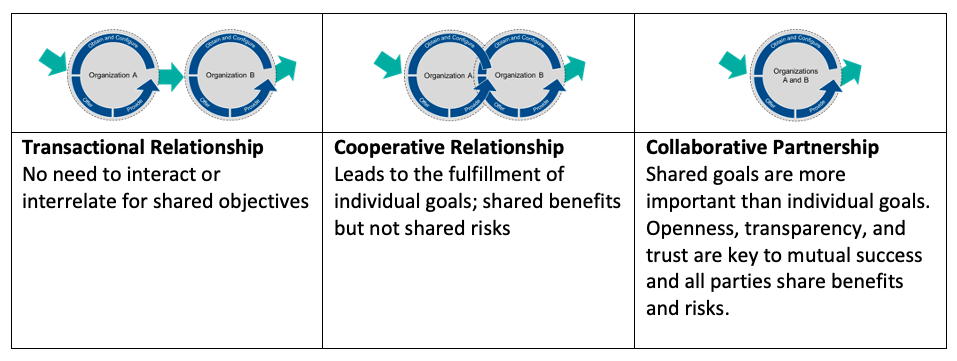To achieve the high-velocity goals of digital transformation, you need to improve your organization's ability to consistently deliver customer value through shared processes.
Organizations that want to accelerate value delivery and improve collaboration, people, and teams traditionally have turned to published IT frameworks and models. But defining, documenting, and automating your processes are not enough.
For shared organizational processes to be sustainable and improved over the long term, you need to establish effective, accountable, and scalable governance and ownership roles. And for these to be effective, you need to create a shared vision, a collaborative culture, effective teaming models, and a shared tooling strategy.
Effective process and practice ownership require interest, time, skills, knowledge, passion, and authority.
Several well-known frameworks address this issue. Lean Six Sigma and COBIT identify the process owner role as a critical control. Agile Scrum says that while self-managed teams have roles with accountability for process elements, the product owner is responsible for product outcomes, while the Scrum master is responsible for the processes.
ITIL describes the need for governance roles, such as process owners and coordinators, to improve the productivity of ITSM practices. These roles focus on process design, communication, awareness, and process advocacy.
Here are five foundational capabilities that will help nurture and sustain any digital transformation practice or shared objective, across complex value chains consisting of internal and external service organizations.
1. Leadership: Creating systems thinking and constancy of purpose
Your behavior and choices reflect the environment you come from, which includes both good and bad attributes demonstrated by current and past organizational leaders.
The tone at the top primarily determines an organization's culture, ethics, focus, drive, direction, and willingness to collaborate. Leadership either intentionally programs organizational culture or develops haphazardly through workers' beliefs and experiences.
There's a direct correlation between an organization's results and its culture, while, conversely, the culture's relationship to the organization's beliefs and experiences reflects its leadership.
In turn, there's a direct correlation between an organization's ability to establish effective process governance roles and how that organization's leaders work with their peers and teams. Organizations in which senior leaders visibly align around common objectives and demonstrate their commitment are better able to establish this role as well as create coherence and a common approach across teams.
Systems thinking and lean leadership practices stress that for a complex system to gain overall speed and velocity, stakeholders must share common values, beliefs, practices, and priorities. A main role of lean leadership is to create a constancy of purpose within the value system.
While you can partially accomplish this by planning systems and focusing on organizational culture, it also depends on process governance—which in turn depends on a leadership team that helps create a systems-thinking culture.
2. Culture: Moving from silo-based to collaborative relationships and shared goals
Both human societies and organizations have natural boundaries where our concept of "us" ends and we consider all others to be "them." While this is normal, challenges can arise when our sense of whom we self-identify with is too narrow. Systems thinking centers on sharing the same values, beliefs, practices, and prioritization of work to effectively achieve common goals.
Establishing efficient process governance structures that cross multiple teams is largely impossible when the sense of "us" is narrow and limited. Building an agreement for shared and common practices within your silo isn't a problem, but introducing a common practice into other groups in a highly siloed culture becomes almost impossible due to cultural constraints.
The solution is to widen the sense of "us" through systems thinking to establish trust-based relationships that reduce silo thinking and move relationships from transactional to cooperative and, ultimately, collaborative.
Figure 1. Readiness for collaboration happens when both parties have built initial trust and are prepared to form a working relationship where individual goals and desires are willingly subordinated to a shared set of values, beliefs, practices, and priorities that can co-create value. Source: AXELOS
ITIL 4 models can help organizations create this larger sense of identity and systems thinking, while enabling a culture and willingness to collaborate across teams.
3. Structure: Creating velocity through cross-functional teams
Vertically oriented structures and management systems are often based on turn-of-the-century design principles that focused on task specialization. While creating localized specialization is important, it can also negatively affect cross-functional collaboration.
Today's fast-paced, highly automated business environment requires both increased speed to market and faster innovation, so leaders must find ways to increase collaboration, engagement, and creativity across teams using shared processes and tools.
Traditional, top-down organizational structures are experimenting with product-oriented cross-functional teams for both development and support. These concepts have been in place for decades in other verticals that have adopted lean manufacturing principles.
The principle of cross-functional collaboration is not new. Developing a project team of members with specializations means forming a temporary teaming structure that shares values, goals, priorities, and outcome-based measures for which they are mutually accountable.
Recent discussion in the IT community has centered on transitioning the project team to a semi-permanent, cross-functional product team. This is not a new concept; Agile Scrum describes the development team and the Scrum master role. DevOps literature describes a DevOps team as having both development and operations members on a product-oriented team.
While people describe DevOps teams as full-stack, this doesn't represent how most organizations use them. Most teams labeled "DevOps" are silo-based.
Creating a team structure that includes the right skills and specializations results in a culture of collaboration that reduces silos and establishes a larger sense of "us." This ultimately makes process ownership roles such as the Scrum master more effective.
4. Performance: Moving to shared outcome versus activity-based measures
Highly effective teams have shared outcome-based measures, rather than individual activity measures.
What is measured is important and, in many organizations, current performance management systems are tied to vertical organizational structures. Teams and individuals are measured on individual activity versus shared process or product outcomes.
The problem is that traditional performance measurement systems often contradict the aim of creating shared process goals. This negatively affects process governance roles; ultimately, people pay attention to what they are measured on.
5. Automation: Moving from best-of-breed point solutions to integrated suites
The desire to use shared tools for shared processes is the final foundational requirement for creating effective process governance. Achieving this goal depends on the previous four enablers.
Vertical, silo-based organization and team structures drive the acquisition process for tools and how they're used. This aligns with the DevOps community's description of Conway's Law: "Any organization that designs a system (defined more broadly here than just information systems) will inevitably produce a design whose structure is a copy of the organization's communication structure."
Unless you align your organization's leadership, culture, team structure, and measurement systems around systems thinking and shared processes, the likelihood of adopting shared tools is quite low. Most organizations preach integrated solutions to their customers, but when it comes to their own acquisition of IT tools, they prefer best-of-breed point solutions over integrated suites.
The use of shared tools comes back to leadership and culture. To address this, leaders and teams must first resolve the following five questions before sharing tools. Can they:
- Agree to agree to agree? (Engage in systems versus silo thinking.)
- Agree on one way to do something? (Reduce complexity and variability.)
- Agree to focus on simplifying how that should be done? (Focus on value-added activities and reducing waste.)
- Agree to use one tool for collaboration? (Move to common tools for each category to improve collaboration and reduce technical debt.)
- Agree on an integrated solution over a best-of-breed point solution? (Help automate delivery pipelines via systems integration.)
Digital transformation requires effective processes
To move from a reactive and low maturity to an improved ability to deliver value consistently and reliably, your organization must establish effective process governance. Ownership roles need to define, deploy, sustain, and improve those processes to support your organization's objectives.
For these roles to fulfill their mandate, you need to have the five critical foundational enablers described above. And for most organizations, there's much work left to do.
Learn how to implement the five foundational enablers with Troy DuMoulin and his colleagues as they offer practical recommendations and approaches for success at Pink Elephant's ITIL 4 in Action online symposium. The event takes place February 22 and 23, 2021.
Keep learning
Get up to speed on digital transformation with TechBeacon's Guide.
Download this free IDC white paper, "Enabling End-to-End Digital Transformation".
See IDC's Futurescape: Top 10 predictions for digital transformation.
How important is digital transformation to your org? Take our survey and find out how you stand next to the competition.
Thinking of making a change? TechBeacon's Careers Topic Center provides expert advice to prepare you your next career move.



